I Wish I Could Try My Tee Age Years Over Again
Why teenagers aren't what they used to exist

There's childhood, adulthood, and the messy scrap in betwixt. Here's how we've defined adolescence throughout history - and why it's time for a new category.
Y
You know the trouble with immature people these days? The younkers call up they're better than the rest of united states, the ephebes are growing upwardly too fast, and the backfisch? Well, they are far too precocious.
If yous don't recognise these words, you wouldn't be alone. They are all onetime terms for adolescents that have fallen out of mutual usage.
A younker was a word used pre-1900 stemming from the Dutch and German terms for a immature nobleman – a little lord – and was besides used to describe a junior sailor. An ephebe was a young Athenian in Aboriginal Greece, aged 18 to 19, who was preparation to exist a full denizen. And a backfisch – literally "baked fish" – is a German language word that popped upwardly in coming-of-age novels published around the turn of the 20th Century. Information technology described a light-headed, spontaneous, adventurous daughter who had an developed'due south independence paired with a child'southward reckless approach to take a chance.
Across history, the words and categories nosotros use to draw young people accept evolved significantly, driven by transformations in culture, work, pedagogy and scientific insight. How accept these factors shaped the terms we use for adolescents today – like "teenager"? And as societal norms shift and new discoveries are fabricated, how might our categories for the young change once again in the hereafter?
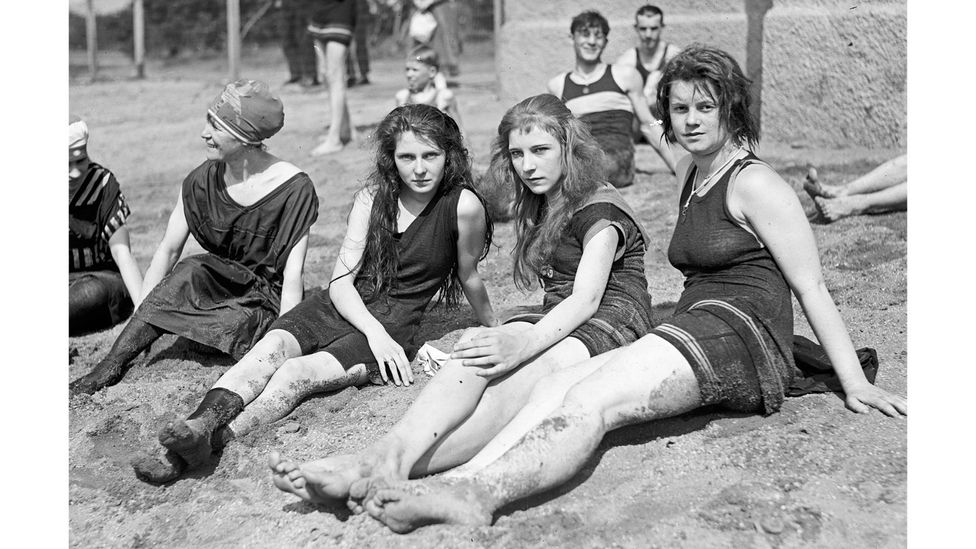
Teenagers were more rebellious in the past, studies show (Credit: Getty Images)
One of the nigh culturally significant inventions of the past century was the teenager. It's hard to imagine that nosotros ever existed without our adolescent years as we experience them now, but if you could fourth dimension-travel back a few centuries, people would find the modern idea of the teenager to be something of an alien concept.
Back in the 1500s, for instance, about Western adolescents would have been workers, recruited into the world of adult labour from as early on as 7 years former, co-ordinate to the historian of childhood Hugh Cunningham of the University of Kent.
In rural economies, this may have involved farm work to back up the family'due south agricultural income, but as industrialisation spread in the 18th and 19th Centuries, many teens became factory workers, grafting alongside their developed peers. In the late 1800s, writes Cunningham, children in the United states of america were contributing around a third of family income past the time their father was in his 50s. There was no universal schooling, and only the wealthiest could tap into a "banking concern of mum and dad" to provide food and shelter.
Equally developed-world living standards and pedagogy policies began to change in the early 20th Century, however, young people were increasingly able to live fully nether the wings of their parents or guardians for longer, supported financially and emotionally. Only even then, the invention of the modern teenager wouldn't happen immediately.
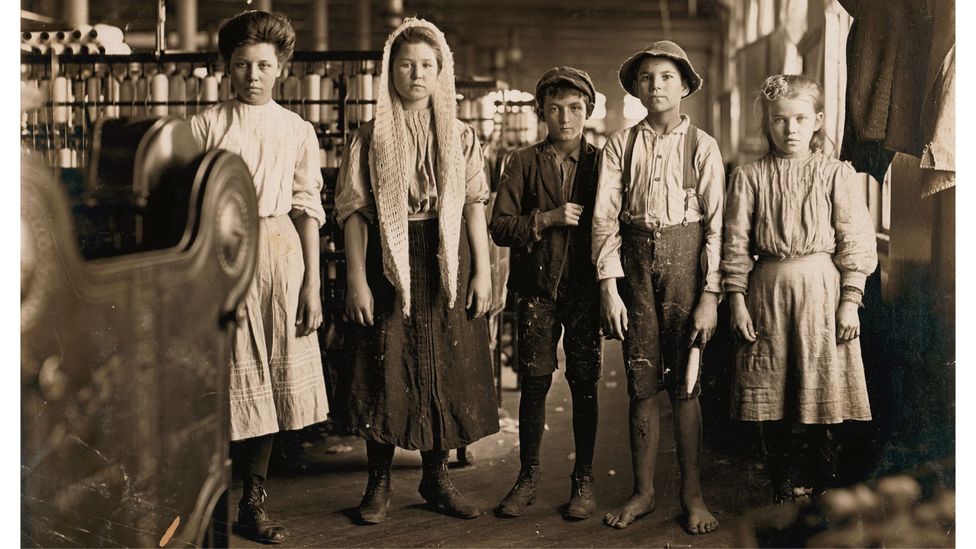
The place of young people in society has changed hugely, driven by shifts in civilization, piece of work, didactics, and scientific insight. (Credit: Getty Images)
Before World War Two, the term teenager (or teen-ager) had occasionally been used, but information technology was only in the tardily 1940s and 1950s that it became more mutual. Around this time, a number of dissimilar forces converged to make that happen.
In rich countries, it became much more likely for a young person to stay in school for their teenage years. In the late 1940s, schooling in the UK was made compulsory up to the age of 15. And in the US, high school graduation rates grew from less than ten% at the kickoff of the century to around 60% by the mid-1950s.
Mail-World War Two, historians also note that social attitudes towards the rights of young people shifted in many Western nations: the sense that young people had a duty to serve their parents weakened, and their own wishes and values began to be listened to more than.
And 1 sector of club that was listening to these needs the most? Commerce. In the 1950s, companies realised that teenagers could also be influencers. They were capable of setting trends and spreading fashions, and therefore could exist marketed to for slap-up turn a profit. As a writer for the New Yorker noted in 1958: "To some extent, the teenage market – and, in fact, the very notion of the teenager – has been created by the businessmen who exploit information technology."
Back and then it was all nigh capitalising on rebellion, hot-rods and rock due north' scroll. Today it's TikTok and… well, I wouldn't know, since I'grand 41 years former. But the point is that the perception of teenagers as cool, trend-setting and influential was – and notwithstanding is – just as much a cosmos of commerce and media as a reflection of reality. Teenage music, fashion and language ripples across the rest of lodge, supercharged by industries established to profit from them.
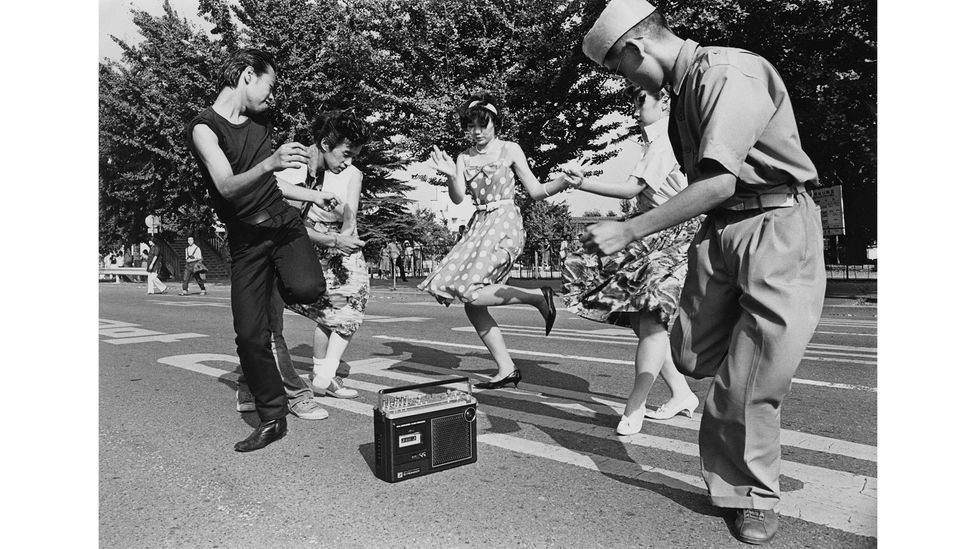
In the 1950s, teenagers emerged as trendsetters in mode, music, flick and trip the light fantastic toe (Credit: Getty Images)
Around the 1950s, you lot tin can also discover anecdotal evidence that cultural perceptions of teenagers as painfully adolescent were condign more widely known, with complaints nearly the trials of parenting pubescent children. In 1955, for example, a adult female called Mrs G wrote to Mary Brown, an desperation aunt for the Great britain Daily Mirror newspaper, complaining virtually her son: "He'southward derisive and he's sulky… why should a boy change similar this?" she wrote. "He resents whatsoever questions. The all-time I get is a polite yes or no, the worst an aroused look which conspicuously tells me to heed my own business."
All this means that the teenager as we know it was very much a 20th-Century invention. The question is, will these cultural perceptions shift again in the future?
Over the by decade or two, there take been some intriguing changes in the attributes of the teenager. The psychologist Jean Twenge of San Diego State Academy notes that teens are growing upwardly more slowly by many measures, compared with their 20th-Century counterparts. A typical 17-18-yr-old in the The states, for example, is now less likely take tried alcohol, have had sex, or caused their commuter'southward licence, compared with similarly-aged teens only 20 years ago. A xiii-14-year-old is less likely to have a task or to accept gone on dates. Meanwhile other measures of early adulthood, such as teenage pregnancy, have reached celebrated lows in the United states of america and Europe.
Twenge points to a number of reasons why growing upward is slowing downward. There's little doubt that technology and the internet has played a major role, meaning more interaction with peers happens online and in the dwelling, where sex, experimentation and trouble are peradventure less likely. For this reason, she calls this latest ingather of young people the "iGen" generation, and has written a book all about their characteristics. But she also points out that some of these trends were already beginning before the online civilisation of the 21st Century, so the internet can't be totally blamed.
Her hypothesis is that teens behave differently depending on how hostile and unforgiving their local environment feels to them, an idea that social scientists called "life history theory". In tougher times in history, teens were forced to take a "fast life strategy", growing upwardly faster, reproducing before and focusing on bones needs. Now life in the West is generally more forgiving, and families are wealthier – at least on average – so it's possible for teens to take a "slow life strategy", delaying the transition to more adult behaviours.
"At times and places where people live longer, healthcare is improve, and education takes longer to stop, people usually make the pick to take fewer children and nurture them more carefully," Twenge explains.
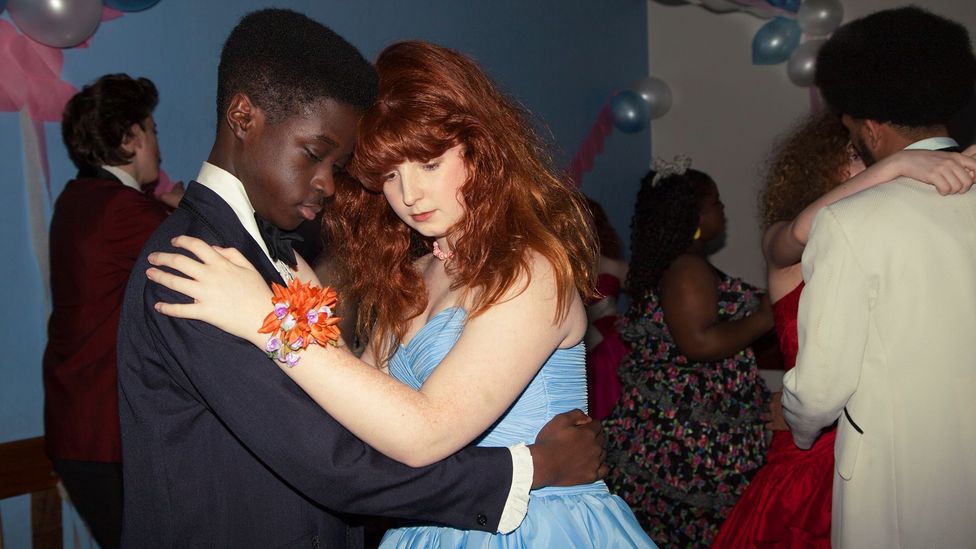
Entire cultural traditions accept evolved around the passage from childhood to machismo, such as prom night (Credit: Getty Images)
There may also exist a greater emphasis on safety amongst this latest teenage generation, Twenge suggests, both physically and emotionally, which encourages young people and their parents or guardians to keep them insulated from the harshness of the adult earth for longer.
And so, what will this mean for our ideas about teenagers if these trends continue? Information technology might suggest that the 20th-Century notion of a teenage rebel-without-a-cause is becoming outdated. Whereas many teenagers in the 1950s and 1960s were driving their ain cars, getting into trouble, and experimenting with beverage and drugs, their similarly-aged counterparts today are often far more clean-living and prophylactic-conscious. If there is reckless behaviour and an urge for independence, information technology's coming later.
A slower path to adulthood is not the merely way that cultural perceptions of youth may demand updating. In recent years, science has also shown that adolescence doesn't terminate at the cease of the teenage years. Past 20 years former, a young person is ordinarily considered an adult: their torso size is fully grown, they can vote, get married, and many accept already entered the workplace. Just the evidence suggests that, by many of import measures, adolescence continues until around the historic period of 24 to 25.
At the end of the teens, puberty may have finished but the development and maturation of the brain is far from complete. Brain imaging shows that white affair, for example, continues to increase into the mid-20s, coupled with a rise in cortical complexity. Some researchers at present also see these years as an important developmental social stage too, where young people are still learning about intimacy, friendship, family, self-expression, and political and social awareness, and so deserve more than support and protection than they currently receive from society.
Could there therefore be a case that these older adolescents should become more conspicuously recognised every bit a distinct demographic group? Should we let them to delay their entry into the fully adult world of life and work? Information technology might seem like coddling to some, but and so again, our ancestors might have said the same about how we treat teenagers.
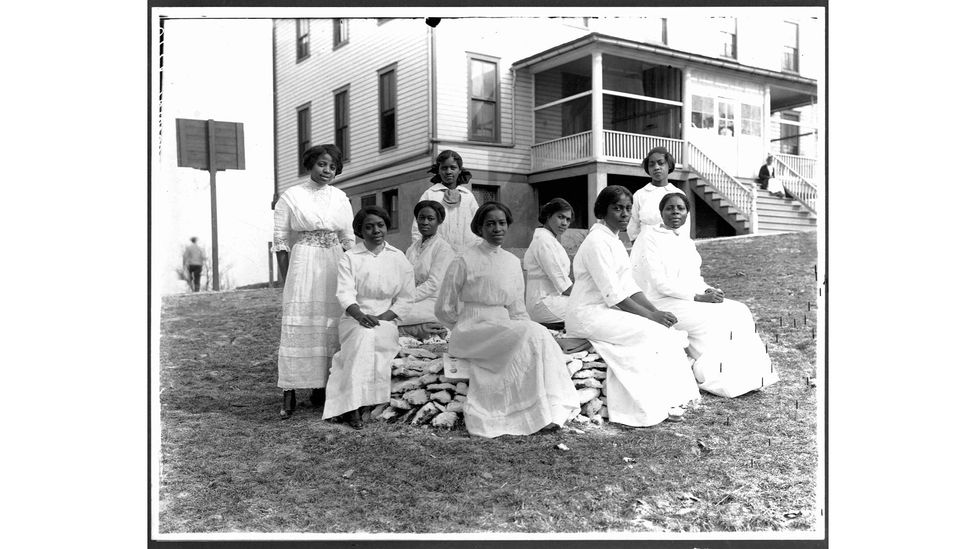
In tougher times in history, teenagers had to grow up speedily and behave like older adults. When life is more forgiving, they tend to take more time (Credit: Getty Images)
Signs of this cultural alter may be happening already. The "boomerang" phenomenon describes recent rises in the number of immature adults returning to the nest to live with their parents after higher educational activity, or because they tin't afford their ain holding or rent. (Some never move out in the first identify.) In the Great britain, effectually 3.5 million unmarried young adults now live with their parents, which is a third more than a decade ago, according to inquiry led by Katherine Colina of Loughborough University in 2020. Wealth imbalances between older generations and today's young people have merely strengthened this trend.
Family unit Tree
It's possible that cultural changes brought by longer lifespans will presently begin to play a role too. As parents piece of work for longer, they may exist in a stronger financial position to back up their older children, equally opposed to retiring. Only that's not all. Lynda Gratton and Andrew J Scott of London Business organisation School propose that greater longevity will also soon begin to make the "three-phase" life of schoolhouse, work and retirement experience outdated. And this, they debate in their book The 100-Year Life, may bring particularly large changes for cultural expectations of immature people in their early on 20s.
"One departure we should consider is the assumption that in our 20s we are meant to go immediately from schooling to a career. In the 100-year life we should consider taking a catamenia of our 20s and dedicating to a new phase, exploration," write Gratton and Scott. "Your decisions early on in life impact the entirety of the residual of it… so it is rather absurd that nosotros expect people in their late teens and early on 20s to make decisions like what direction they desire their lives to have. Instead they should have a period of exploring the globe and trying different paths."
What's curious is that this specific menses of life, mail-teen, doesn't have a commonly known name to describe it, at least in English language. Perchance information technology should. After all, pre-teens have their own moniker as "tweens". Some researchers have labelled the menstruum pre-25 every bit "prolonged boyhood", but perhaps another name could exist adolthood – spanning the teenage and adult worlds.
And if the idea of adolts doesn't take hold of on, someone tin can surely find a meliorate name: after all, from ephebes to younkers to backfisch, we take been coining new categories for young people for nigh of history.
*Richard Fisher is a senior journalist for BBC Future and tweets @rifish
--
Bring together one million Future fans by liking us on Facebook , or follow united states on Twitter or Instagram .
If you liked this story, sign up for the weekly bbc.com features newsletter , chosen "The Essential List". A handpicked selection of stories from BBC Future , Culture , Worklife , Travel and Reel delivered to your inbox every Friday.
Source: https://www.bbc.com/future/article/20220124-why-teens-arent-what-they-used-to-be
0 Response to "I Wish I Could Try My Tee Age Years Over Again"
Post a Comment